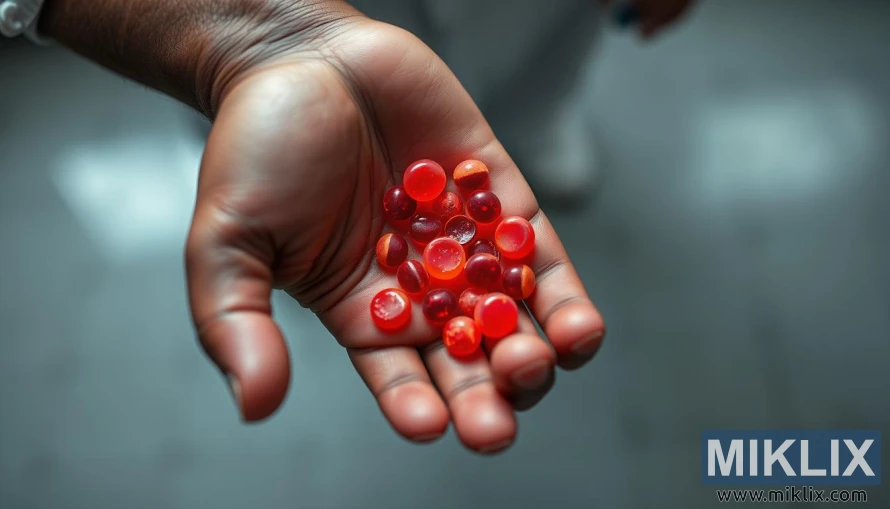Image: Sickle cell disease illustration
Published: June 26, 2025 at 2:24:06 PM UTC
Last updated: September 26, 2025 at 2:22:26 PM UTC
Clinical cross-section of a human hand highlighting blood vessels and sickle-shaped red blood cells, illustrating the effects of sickle cell disease.
The image presents a striking, intimate view of an open human hand holding a collection of deep red, glossy capsules or beads that glisten under the light. The perspective is close and deliberate, with the camera angle positioned slightly above, emphasizing both the contours of the hand and the vibrancy of the objects it carries. The hand itself, with its subtle lines, creases, and tonal variations, conveys warmth and humanity, providing a stark yet evocative contrast to the clinical implications suggested by the subject matter. The red capsules are scattered unevenly across the palm, their rounded forms varying slightly in shape and size, some appearing smooth while others catch the light in ways that reveal small imperfections. Together, they create a visual representation not just of medication, but of the delicate intersection between life, science, and human vulnerability.
The background remains softly blurred, its neutral, bluish-gray tones serving to isolate the hand and its contents as the undeniable focal point. This choice of shallow depth of field ensures that the viewer’s eye is drawn instantly to the luminous reds in the palm, their glossy surfaces reflecting pinpoints of light that make them appear almost jewel-like. Yet beneath the surface beauty lies a weightier context: these bright objects symbolize more than simple capsules. They are a stand-in for the sickle-shaped red blood cells that define sickle cell disease, a serious and chronic medical condition that alters the very foundation of human blood. In this way, the photograph balances a duality—its aesthetic allure contrasting with the sobering medical reality it seeks to convey.
The lighting in the image is precise, bordering on technical, illuminating every curve and texture with clarity. Highlights on the capsules accentuate their roundness and translucency, while subtle shadows along the fingers and palm add depth, anchoring the composition in a sense of realism. The overall tone is clinical yet compassionate, allowing the scientific subject matter to remain grounded in a deeply human context. The open hand, so often associated with offering or receiving, takes on symbolic significance here: it becomes both a vessel of vulnerability and a gesture of resilience. It reminds the viewer that behind every clinical description of sickle cell disease lies a human life, lived with the challenges of pain, fatigue, and the ongoing reliance on medical support.
What makes the image especially engaging is its capacity to communicate complex medical ideas through a single, accessible visual metaphor. By presenting the capsules as tangible representations of the disease’s cellular distortions, the image manages to simplify without diminishing the gravity of the condition. It informs while also evoking empathy, urging the viewer to recognize not only the scientific but also the personal dimensions of this illness. The hand serves as the bridge between the abstract concept of diseased cells and the lived experience of individuals affected by them, grounding the medical narrative in touch, texture, and humanity.
Ultimately, the composition achieves a delicate balance between science and art, between clarity and compassion. Its neutral palette ensures focus remains on the vibrancy of the red capsules, while the tight framing and overhead angle create intimacy, inviting viewers into a moment that is both instructive and reflective. By highlighting the visual and symbolic parallels between medication, blood cells, and the human hand, the image powerfully conveys the seriousness of sickle cell disease while maintaining a sense of dignity and respect for those who live with it. The result is not only visually captivating but also deeply thought-provoking, embodying the intersection of medical precision and human experience.
The image is related to: Fuel Your Fitness: How Glutamine Supplements Boost Recovery and Performance

